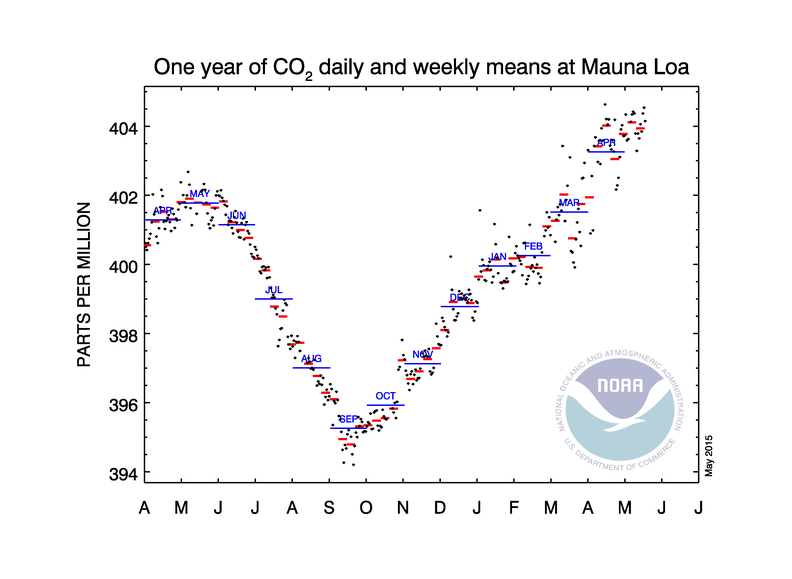
May 18, 2015
Within just the last three weeks, new data has illustrated the steady march of climate change.
NASA information shows that a huge intact portion of a massive ice shelf in Antarctica is rapidly melting and expected to degrade within a few years, contributing to sea level rise. A separate study reported that the monthly global concentration of climate-forcing carbon dioxide emissions has reached a new high at 400 parts per million.
And two UCLA studies that look at the effects of climate change show that the Los Angeles region can expect to be slammed by many more extreme heat days in 2050, which brings greater water demands and greater energy demands.
If the combined force of this news makes you want to curl up into a fetal position and block out the world or, perhaps worse, switch to the solitaire app on your digital device, hold on just one minute.
There’s a piece of news that didn’t get a ton of media attention that provides a sliver of optimism. It suggests that humanity’s chances of doing something meaningful to slow down—maybe even permanently weaken—that climate disruption march are looking brighter.
The news came via the California Air Resources Board (CARB) and its concept paper about how to address what are known as “short-lived climate pollutants” or SLCPs.
Short-lived climate pollutants are a class that includes black carbon, methane, and fluorinated gases (or F-gases). Each of these pollutants contributes to climate change and can be much more potent per unit than a unit of carbon dioxide. But unlike carbon dioxide, the short-lived climate pollutants are, well, short-lived. They break down and disappear in the atmosphere within a decade or so, while carbon dioxide persists for a hundred years.
Also, these short-lived climate pollutants are not technologically challenging for the most part. It’s relatively easy to cut these pollutants dramatically in a short timeframe. For instance, black carbon pollution includes smoke from wood fires and diesel soot. Reducing recreational burning (as in fireplaces) and using different or more efficient engines are examples of a few of many known ways to cut black carbon.
For a number of years, some environmental advocates and scientists have been urging greater attention to short-lived climate pollutants, in part because they also cause ground-level air pollution. Diesel particulate matter, for instance, is a toxic air contaminant, a known carcinogen, and an acute health problem for people living near freeways or ports or rail yards.
Last year, in the last few weeks of the two-year legislative session, Senator Ricardo Lara introduced a bill (SB 605) that required the California Air Resources Board to develop a plan to reduce short-lived climate pollutants. The recently released concept paper is the first step toward that plan.
As the paper notes, the state has already done quite a few things to reduce short-lived climate pollutants. Over the years, its air pollution program to cut diesel emissions to protect public health, which has included some controversial regulations and not-so-controversial incentive funds to drive earlier retirement of dirty diesel trucks, has been notable for cutting black carbon. The agency has also begun a regulatory process to cut methane pollution from oil and gas drilling in California, and it has a program to address F-gases.
But, as the agency also notes in the concept paper, there’s much more California can do.
So where’s the optimistic part? Air pollution agencies around the world have begun to pay attention to short-lived climate pollutants. Some even look to California’s technical know-how to help practically regulate these pollutants. And all of this can make a difference and slow down climate change.
According to the concept paper, “existing strategies can cost-effectively reduce global methane emissions an estimated 40 percent and black carbon an estimated 80 percent below reference levels in 2030. Additionally, a new global phase-down of HFCs under the Montreal protocol and other efforts could cut the expected use of F-gases by more than 50 percent in 2030.”
On May 27, CARB will hold a Sacramento workshop, which will be webcast, about the concept paper. Sometime this summer, the agency will release a draft plan for addressing the SLCPs.
There are rumblings that dairy farmers and certain other agricultural interests are not happy about the concept paper. They worry that they’re going to face new regulations. The fact is that farm animals and dairy waste are among the leading sources of methane in the state and represent one area where changes in practices can substantially reduce emissions.
The Brown Administration has been actively looking for ways to positively influence the global discussion about climate change and to make sure the United Nations climate summit in Paris in December results in greater, more unified action around the world.
The concept paper and the plan for short-lived climate pollutants are among the contributions the state can offer at Paris. But first the plan has to be a good one that the state is willing to implement right away, despite the usual industry pushback on regulation.
As the other climate change news suggests, there’s no time to waste.
Sincerely,

Kathryn Phillips
Director
Sierra Club California is the Sacramento-based legislative and regulatory advocacy arm of the 13 California chapters of the Sierra Club.
Please consider becoming a sustaining donor.